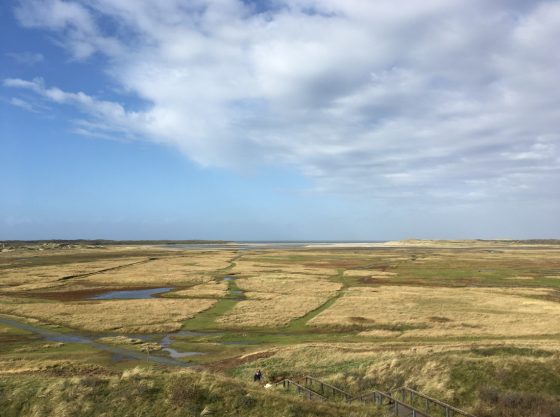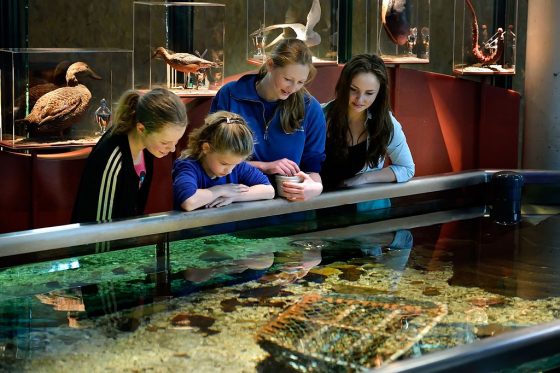DutchNews.nl destinations: getting windblown in winter on Texel


In the winter, a wander along a blustery Texel beach is a popular way to blow the cobwebs away – lekker uitwaaien, as the Dutch would say. Robin Pascoe visited the biggest of the Wadden Sea islands.
Just a few minutes by ferry from the navy town of Den Helder, Texel’s regular population of over 13,000 is constantly inflated by a steady stream of holidaymakers all year round, mainly from the Netherlands and Germany.
Texel is a something for everyone kind of place. The dune landscape is a haven for bird life and around one third of the island is a designated nature reserve. In the summer, tourists flock to its enormous sandy beaches, and the popular west coast villages of De Koog and De Cocksdorp, where most of the holiday villages and hotels are located.
Despite Texel’s popularity, it is easy to escape the crowds – but you will need to book the more popular restaurants in the evening. The local tourist office, which is extremely helpful, has a very comprehensive website in English.
Things to do
Museum Kaap Skil
Oudeschild, the little fishing port on the south east coast, is home to the Museum Kaap Skil. The story of the Texel adventurers is told in vivid detail in the basement, while upstairs is case upon case of ‘treasure’ reclaimed from the surrounding seas. Outside, you can visit a working mill, several traditional fishermen’s cottages and a warehouse containing part of a massive collection of finds made by beachcombers which is truely bizarre. Lots to entertain children as well.
The Slufter
The Slufter is a nature reserve on the west of the island, covering a large area of dune, marsh and sandbanks and populated by a huge variety of bird life. In total, the Slufter covers about 700 hectares, but that includes a huge stretch of tidal flats. There are several guided walks of different lengths and a wheelchair ramp down to the walkway for the less able bodied.

Lighthouse
The red lighthouse nestling in the dunes at the northern end of the island is open to the public, if you can climb the 118 steps to the gallery. The view, even on a rainy day, is stunning. There are two nice restaurants nearby where you can escape the wind and have a big bowl of pea soup instead.
Wezenspyk
A dairy farm with a cheese shop, plus a short guided walk across the polder to a traditional and restored Texel barn – you will see these distinctive barns all over the south of the island – so its interesting to get a peek inside. Wezenspyk has won prizes for its Texel sheep and goats cheese and we did, of course, buy them on the premises to bring home.
Ecomare
This combination of a sea life rescue centre and natural history museum is situated on the western side of the island and is a permanent home to two porpoise and some 15 seals which can no longer be released into the wild. The aquariums have a wide variety of native sea life – see how many flat fish you can spot – while the museum section includes the skeletons of several whales and other strange creatures which have washed up on the shore. Great for kids.

Where to eat
Texel has its fair share of snack bar/pancake/burger and chips joints, as any holiday destination, but it also has some highly rated eateries as well. Top of the bill is fish restaurant T’ Pakhuus on the harbour front in Oudeschild which is described by Lekker magazine as a ‘culinary pearl’ but was fully booked when we were on the island.
We had a perfectly respectable, if somewhat noisy, steak and chips dinner De Kastagneboom in Den Burg, the main town, and a very good four-course meal with local fish and lamb – and their own liqueurs – in Topido, De Cocksdorp. We can also recommend lunch at beach bar Paal 17, even in winter.
Where to stay
There are hotels galore and the Texel tourist office has a wide range of privately-owned holiday houses and an easy to use website in English. We stayed at Vijverhof on the edge of a forest, which has a large, secluded garden, solar panels and sleeps up to 12.
If you are renting a holiday house, check whether the price includes final cleaning, sheets and towels and energy costs. These are often added on as extras.
How to get there
Drive, take the train or a bus to the ferry terminal in Den Helder, then take the ferry. It’s an hourly service – every 30 minutes in peak periods – and you can’t book. A return ticket costs €2.50 per person and €18.20 for a car of less than 2.5 metres. If you do take a car buy a parking ticket online for your whole stay – it saves a lot of money!
If you are fit and love cycling, you don’t need to take a car at all – there are lots of places to hire bikes – but it can get heavy going cycling into the wind so don’t under estimate the long trip back after a day out.
Anything else?
Combine a visit to Texel with a boat trip over to neighbouring Vlieland from De Cocksdorp or island hop up the entire Wadden chain.
Thank you for donating to DutchNews.nl.
We could not provide the Dutch News service, and keep it free of charge, without the generous support of our readers. Your donations allow us to report on issues you tell us matter, and provide you with a summary of the most important Dutch news each day.
Make a donation